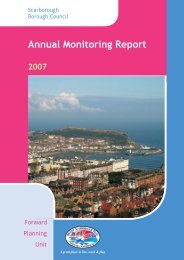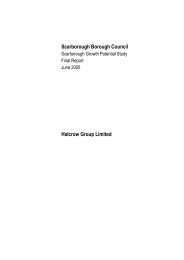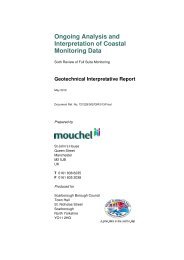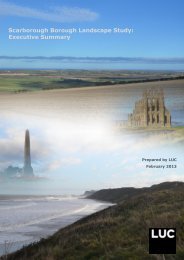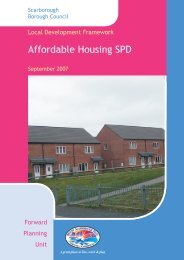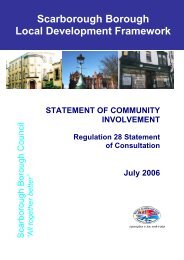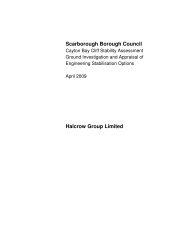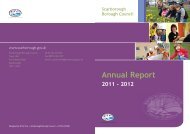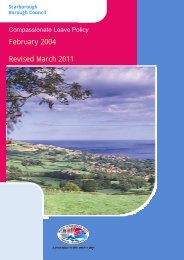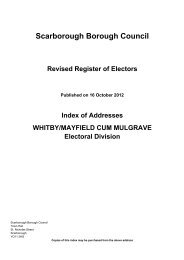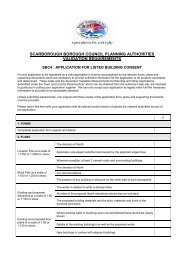The Cayton and Flixton Carrs Wetland Project - Scarborough ...
The Cayton and Flixton Carrs Wetland Project - Scarborough ...
The Cayton and Flixton Carrs Wetland Project - Scarborough ...
Create successful ePaper yourself
Turn your PDF publications into a flip-book with our unique Google optimized e-Paper software.
David Renwick, <strong>Project</strong> Officer, <strong>Cayton</strong> <strong>and</strong> <strong>Flixton</strong> <strong>Carrs</strong> Wetl<strong>and</strong> <strong>Project</strong>, 19/04/06<br />
<strong>The</strong> <strong>Cayton</strong> <strong>and</strong> <strong>Flixton</strong> <strong>Carrs</strong> Wetl<strong>and</strong> <strong>Project</strong> – What?<br />
Over the past 10 to 15 years, it has become more <strong>and</strong> more difficult for farmers in the project area to<br />
make a living from the l<strong>and</strong>. This is because of problems with the area's drainage system, peat<br />
compaction <strong>and</strong> increased rainfall, meaning the l<strong>and</strong> has become wetter - making harvesting crops<br />
difficult. <strong>The</strong>se problems could be made worse by climate change <strong>and</strong> global warming as rainfall<br />
levels are expected to increase <strong>and</strong> storms become more frequent. <strong>The</strong> recent changes to UK<br />
agriculture <strong>and</strong> the introduction of the new Environmental Stewardship Scheme have provided a<br />
possible alternative income for farmers, paying them to deliver environmental benefits. It is hoped that<br />
these schemes can be used to reverse the recent declines in farm wildlife, especially farml<strong>and</strong> plants<br />
<strong>and</strong> birds. <strong>The</strong> <strong>Project</strong> will help farmers to apply for the Higher Level Stewardship Scheme, which<br />
will then pay them to create <strong>and</strong> manage new wetl<strong>and</strong> habitats.<br />
<strong>The</strong> project was started by <strong>Scarborough</strong> Borough Council on a small piece of l<strong>and</strong> near Star Carr, the<br />
aim here was to create a small wetl<strong>and</strong> area, including scrapes <strong>and</strong> wet grassl<strong>and</strong>. However, when<br />
local farmers heard of these plans they also became interested in getting involved in the project. This<br />
led to a widening out of the project into surrounding farml<strong>and</strong> <strong>and</strong> a number of other organisations<br />
including the Environment Agency, English Nature, <strong>The</strong> Royal Society for the Protection of Birds<br />
(RSPB), the Rural Development Service <strong>and</strong> North Yorkshire County Council became involved.<br />
Along with <strong>Scarborough</strong> Borough Council <strong>and</strong> the local farmers these organisations now form the<br />
project partnership.<br />
<strong>The</strong> main aim of the <strong>Cayton</strong> <strong>and</strong> <strong>Flixton</strong> <strong>Carrs</strong> Wetl<strong>and</strong> <strong>Project</strong> is to restore floodplain habitats to the<br />
Vale of Pickering l<strong>and</strong>scape at <strong>Cayton</strong> <strong>and</strong> <strong>Flixton</strong> <strong>Carrs</strong> <strong>and</strong> the surrounding areas. <strong>The</strong> primary<br />
objectives of the <strong>Project</strong> include the following;<br />
• To create a range of valuable wetl<strong>and</strong> habitats<br />
• To provide an alternative to intensive agriculture<br />
• Alternative income for farmers<br />
• Contribute to local <strong>and</strong> national targets on nature conservation covered by local <strong>and</strong> UK<br />
biodiversity action plans<br />
• Contribute to conservation of nationally important archaeological <strong>and</strong> paleo-environmental<br />
deposits<br />
• Develop opportunities for wildlife based tourism<br />
• Improve flood storage<br />
<strong>The</strong> project aims to create a l<strong>and</strong>scape containing a mosaic of wetl<strong>and</strong> habitats of wet grassl<strong>and</strong>, pools,<br />
flushes, reedbeds <strong>and</strong> wet woodl<strong>and</strong>s, with extensive areas of wet grassl<strong>and</strong>s grazed by cattle, sheep<br />
<strong>and</strong> other livestock. A predominantly open l<strong>and</strong>scape, with soil conditions suitable for breeding<br />
waders such as redshank, snipe, curlews <strong>and</strong> lapwings with flocks of wintering ducks, waders <strong>and</strong><br />
geese on shallow flooded l<strong>and</strong> near the river. Watercourses will be rich in wildlife supporting water<br />
voles, otters, dragonflies <strong>and</strong> aquatic plants. We only want to create wetl<strong>and</strong> where it is sustainable,<br />
appropriate <strong>and</strong> site conditions allow us to do so. Where wetl<strong>and</strong> habitats can not be created we will<br />
look to benefit other wildlife as much as we can, especially farml<strong>and</strong> birds. <strong>The</strong> habitats will be<br />
managed through close working with the farming community to underst<strong>and</strong> <strong>and</strong> manage water levels<br />
in the project area. With traditional farming at its heart to maintain a functional, working farmed<br />
l<strong>and</strong>scape. <strong>The</strong> project is committed to making decisions in an open <strong>and</strong> inclusive way to ensure that it<br />
achieves environmental, social <strong>and</strong> economic gains.<br />
Page 4 of 6



